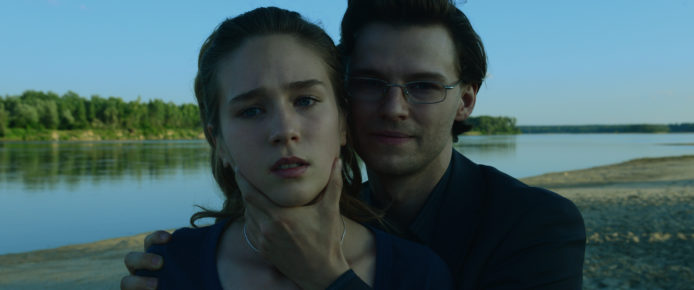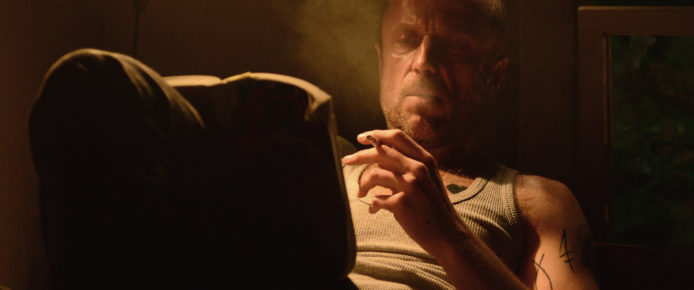NEWS
29/03/2017
“Amok” – new film by Kasia Adamik
– We never wanted to make a film about the real Krystian Bala, about the real murder, about the actual history of the book. What would be the point? – asks Kasia Adamik, the director of “Amok”, now playing in Polish cinemas. While “Amok” toys intriguingly with the tropes of traditional crime films, it’s also a fascinating psychological drama focused on events that occur in the conscious and subconscious.
Widely expected to be a classic crime pic, Kasia Adamik’s Amok shakes up all assumptions. Its opening scenes show the protagonist, Krystian Bala (Mateusz Kościukiewicz), murdering a woman while his wife makes lunch on the other side of the wall. Bala is under investigation for another unsolved murder, but the policeman in charge of the investigation (Łukasz Simlat) meets the suspect for a beer and offers him a sort of a partnership instead of painstakingly gathering evidence against him.

Zofia Wichłacz and Mateusz Kościukiewicz in AMOK / photo Witold Bączyk
Here’s a killer; there’s a detective; hasn’t this trope been done to death? However, Adamik flips the perspective and stacks up doubts, methodically dismantling the two roles defined at the start of the story – the murderer and the law enforcement officer. Maybe the murder is merely the product of twisted imagination, a work of fiction. Maybe the pursuit of the killer is actually a metaphor for chasing the detective’s repressed, unfulfilled hopes and wishes.
“Richard Karpala’s script caught my attention precisely because it flipped genre conventions,” said Kasia Adamik. “I wanted to make a cautionary tale against getting seduced by easy solutions – a cinematic journey that requires effort to get through. Like pushing through dense air, sluggish and heavy. That’s why I made it hyperrealistic, because our world only appears to be real. That’s why there’s strangulation and underwater scenes. Amok is a claustrophobic picture about two men tangled up in their game of cat and mouse, out of breath, lost like rats in a labyrinth.”
Here’s a killer; there’s a detective; hasn’t this trope been done to death? However, Adamik flips the perspective and stacks up doubts. Maybe the pursuit of the killer is actually a metaphor for chasing the detective’s repressed, unfulfilled hopes and wishes
There is, of course, the book as well – the true starting point of the film. Krystian Bala’s Amok, published in 2003, was supposedly the clue that led the police to the killer’s trail. The murder described in the novel uncannily resembled a real unsolved murder case. The media quickly picked up the story of a man who described his bloody handiwork in a novel. Then came the news pieces and investigative reporting; Krystian Bala became a hot topic in Poland and abroad (as evidenced by the famous article in The New Yorker).
“Most of the script is pure fiction apart from a few details, the protagonist’s name, and his book, which is quoted in the film,” Adamik explained. Still, the novel’s importance is greatly exaggerated in the movie – it wasn’t a commercial success and the court didn’t admit it as evidence in the murder trial.

Łukasz Simlat in AMOK / photo Witold Bączyk
“We never wanted to make a film about the real Krystian Bala, about the real murder, about the actual history of the book. What would be the point?,” Adamik asked. “Watching the debate about our movie I’m reminded of the outrage over Teatr Powszechny’s recent production of The Curse, baselessly smeared as promoting Nazism. Both theater and cinema are a manufactured reality; there is an assumption of detachment and multiple meanings, we don’t approach onstage or onscreen depictions like the real world. Provocation and experimentation are tools of theater and cinema, as well as of literature. That’s what sets works of art apart from bland morality tales or newspaper journalism – art tries to influence and shock the viewer, stimulate them to stop thinking literally.”
The question whether Bala is actually a killer or just wants to be a murder suspect remains unanswered in the film
The question whether Bala is actually a killer or just wants to be a murder suspect remains unanswered in the film. Murder is, in a way, a secondary concern in Amok: the truly fascinating part is its portrayal of Krystian Bala as a psychopath who doesn’t need to kill to be terrifying.
In Without Conscience. The Disturbing World of the Psychopaths Among Us, Robert D. Hare describes psychopaths as superficially charming people whose eloquence usually masks a lack of erudition. They’re narcissists convinced of their own uniqueness, incapable of remorse or empathy, but extremely adept at manipulation. Only a fraction of psychopaths turns to crime – most of them lead ordinary lives while persistently undercutting and destroying other people, whether strangers, family members, or colleagues. “The key characteristic of psychopaths is their inability to feel emotions,” claimed Adamik. “Psychopaths don’t feel like other people do, but they start learning to pretend at a very early age, stepping into the roles they’re expected to play.”
The protagonist likes to mix sex with violence. He objectifies women and only picks up those he deems “ugly”, because the pretty ones don’t turn him on. He holds forth on Nietzsche, but his reading of the idea of the Übermensch is superficial, as if trying to elevate himself through a famous philosophical theory. Still, in Mateusz Kościukiewicz’s stellar performance the demonic façade cracks repeatedly, not just when this allegedly infallible criminal makes the utterly elementary mistake of selling the victim’s cell phone three days after the murder.
“Our Krystian is cold and calculating, but something’s broken deep inside him,” the director admitted. “He’s yearning for something, maybe for a different life, but in fact he’s very lonely and even uncool – he has no friends, he can’t talk to people, he doesn’t get jokes. He’d like to seem cool, but he can’t hide the fact that it’s just a mask.”

Mateusz Kościukiewicz in AMOK / photo Witold Bączyk
Bala isn’t the only one to wear a mask in this film – policeman Jacek Sokolski turns out to be a mirror image of Krystian rather than his enemy. If Bala is truly a madman, at least he tries to appealingly package and cynically market his insanity. Sokolski, excellently portrayed by Łukasz Simlat, isn’t capable of that. Internally torn by conflicting emotions, he’s rebelling against his true self and envious of what he cannot attain. The policeman can’t even put it into words or find the tools to comprehend his inner turmoil.
Adamik agrees that the character of Sokolski is mainly driven by envy: “Envious of Bala, the policeman mostly covets the façade Bala created for himself. Sokolski finds Krystian’s freedom and lack of restraint fascinating. Maybe he’d like to kill someone himself, but he can’t; maybe he’s more violent and unpredictable than Krystian – but he feels shackled within.”
Maybe “Amok” is a dream – the dream of men dreaming of power and crashing against the limitations of flesh, mind, morality, immorality, and art…
I asked Kasia Adamik if she made a film about male hubris; she didn’t deny it. “There’s something desperately sad about these guys – forever building up their egos, they still can’t achieve satisfaction. They try to achieve something, but can’t even get close to their ideals. They’re constantly trying to prove something to themselves and to others. They’re struggling, trapped within themselves.”
Women appear in Amok as well. Are they victims of male chauvinism (like the girl Krystian has sex with in a nightclub restroom) or do they hold all the cards and drive the guys to frustration? The most prominent female character, Krystian’s wife Zofia (Zofia Wichłacz), is also the most interesting. As Adamik says, “A noir film wouldn’t be right without a femme fatale.” A submissive, almost browbeaten housewife at the start of the movie, Zofia transforms into a mysterious feminine force of nature.
She seems the least complex character, because she’s also the most symbolic – not a flesh-and-blood woman, but the personification of male fantasies, desires, and fears. The closer we get to the end, the more dreamlike Zofia becomes. And maybe the cinematic Amok is but a dream – the dream of men dreaming of power and crashing against the limitations of flesh, mind, morality, immorality, and art…

Zofia Wichłacz in AMOK / photo Witold Bączyk
Planned as an internationally coproduced English-language film, Amok was shot in Polish, with a Polish cast and crew. “I find making movies in Poland truly pleasant and liberating,” Adamik said. “It’s a smaller production with a smaller group of people, but they’re all fully into it, creative and involved in the process. Which made things slightly tricky when it came to actors – Mateusz and Łukasz constantly stayed in character, so lunch breaks got a bit unpleasant,” joked Adamik.
Interestingly enough, the script of this Polish film was written by American Richard Karpala. Karpala’s parents were Polish and he understands the language a little. “Finding it was like a dream come true: I, a film director, received an excellent script I’d be thrilled to work with,” Adamik recalled. ”I was seduced by its extremely visual and unusual nature – the imagery told one story while the dialogues told another. Does this mean American screenwriters are better? Not at all! Polish ones are just short on time and money for research, iteration, corrections and all the tedious work.”
Though The Offsiders (2008) brought Kasia Adamik wide acclaim, her directorial debut was the excellent Bark! (2002), screened in the main competition of the Sundance Film Festival. Like Amok, this was a film about madness. Why? “Maybe because I’m painfully normal, even boring, in my daily life,” Adamik laughed. “I don’t suffer inner torment – which is not to say I don’t find it fascinating. But I don’t like excitement, I don’t even think about extreme sports. I need to be calm on set as well, because stress blocks my creativity.”
Over the past 15 years Adamik directed three films, collaborated with her mother Agnieszka Holland on a number of other projects (like Janosik. A True Story and Spoor) and filmed several TV series, including Prime Minister and Into Deep Water. “I haven’t been slacking,” she asserted. Now, however, Adamik wants to pick up the pace – she has several new projects lined up, including one based on a short story by award-winning novelist Olga Tokarczuk. Adamik is also honing her skills at film editing.
Having worked in the United States and many other countries, Adamik nevertheless feels most comfortable in Poland. If there’s anything she’d like to change in Polish filmmaking, it’s the fact that directors who aren’t coproducers have basically no control over all aspects of their film once it’s finished, from trailers to festivals it’s to be screened at. “I’d like Polish cinema to be director-based like it used to be instead of producer-oriented,” Adamik said. “After all, this is our greatest asset.”
—Paweł T. Felis (translated by Dariusz Kołaczkowski)